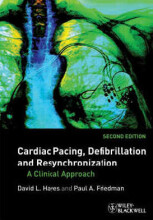Summary: Cardiac Pacing, Defibrillation And Resynchronization : A Clinical Approach | 9781405167482 | David L Hayes, et al
- This + 400k other summaries
- A unique study and practice tool
- Never study anything twice again
- Get the grades you hope for
- 100% sure, 100% understanding
Read the summary and the most important questions on Cardiac pacing, defibrillation and resynchronization : a clinical approach | 9781405167482 | edited by David L. Hayes, Paul A. Friedman.
-
1 clinically relevant basic of pacing and defebrillation
-
Were is the SA node located
At the junction of the right atrium and the superior vena cava -
Which bundle conduct the pulse through the left and the right atria
Bachmans bundle -
What is the Function of the AV node
Physiological delay between atrial and ventricular contraction
can function as a pacemaker
regulate the number of impulses reaching the ventricels -
Cardiac conduction system
SA node
AV node
Purkinje fibers -> the bundle of HIS
diverse bundle branches -
1.1.1 Electrophysiology of myocardial stimulation
This is a preview. There are 1 more flashcards available for chapter 1.1.1
Show more cards here -
What creats phase 0 of the action potential
Influx of extracellular NA+ into the myocyte -
What happens in Phase 1 of the action potential
Short period of overshoot potential to + 20mV -
What is Phase 2 of the action potential
Plateau period created by the inward calcium and NA+ balanced against outward K+ currents. -
What happens in Phase 4 of the action potential
The gradual opward drift in transmembrane potential repeats. -
How does neighbouring cells depolarisize
Passive conductionvia low resistance inetrcellular connections called the gap junctions -
1.1.1.1 Pacing basics stimulation threshold
This is a preview. There are 16 more flashcards available for chapter 1.1.1.1
Show more cards here -
What is called the stimulation threshold
The minimal amount of energy required to produce this polarization
- Higher grades + faster learning
- Never study anything twice
- 100% sure, 100% understanding
Topics related to Summary: Cardiac Pacing, Defibrillation And Resynchronization : A Clinical Approach
-
Variations in stimulation threshold - Sensing - Lead design
-
Indications for pacemakers, ICD´s and CR patients who benefit from Cardiac Rhythm devicesT±Indetifying - Indications for permanent pacing
-
Venous approaches - Ventricular lead placement - coronary sinus lead placement
-
Timing cycles
-
Programming Maximizing benefit and minimizing morbidity programming - SVT en VT discriminatoren
-
Programming - rate adaptive pacing with cardiac resynchronization devices
-
Troubleshooting - Focused troubleshooting - ICD troubleshooting
-
Electromagnetic interference: Sources, recognation and management - Pacemaker response to noise
-
How to determine pacing sites by ECG en chest X ray
































